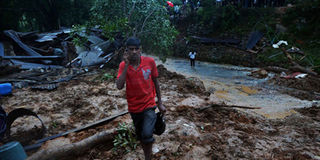100 buried alive in S. Lanka mudslide

Sri Lankan residents stand outside a damaged building at the site of a mudslide caused by heavy monsoon rains in Koslanda Village in central Sri Lanka on October 29, 2014. Around 100 people were buried alive in a tea-growing region of Sri Lanka. FILE PHOTO | AFP
What you need to know:
- One witness spoke of hearing a noise like thunder as part of a mountainside collapsed onto the estate, burying some of the workers’ homes in nine metres of mud and debris.
- The annual monsoon brings vital rains for irrigation and electricity generation but also causes frequent loss of life and damage to property.
KOSLANDA
Around 100 people were buried alive in a tea-growing region of Sri Lanka Wednesday as mudslides triggered by monsoon rains washed away their homes on a plantation, disaster officials said.
One witness spoke of hearing a noise like thunder as part of a mountainside collapsed onto the estate, burying some of the workers’ homes in nine metres of mud and debris.
“What I gathered is that about 100 people have been buried alive,” Disaster Management Minister Mahinda Amaraweera told AFP after visiting the site in the eastern Koslanda region.
“There is no chance they could have survived,” said the minister, as other officials said 16 people were confirmed dead.
Hundreds of soldiers, who initially used their hands to dig for survivors, had switched to operating excavators by evening but hopes had faded of finding anyone else still alive.
“Anyone buried under the mud has a very slim chance of surviving,” Disaster Management Center spokesman Sarath Kumara told AFP.
FREQUENT DAMAGE
The annual monsoon brings vital rains for irrigation and electricity generation but also causes frequent loss of life and damage to property.
The minister said the search and rescue mission led by troops had now turned into a recovery operation, which they hope to resume at first light on Thursday.
He said using heavy machinery also had to be done carefully because the surrounding hills were unstable. “Initially we estimated the missing number at 300, but most of them were at school or work,” the minister said.
“We have already started relief operations to provide them with shelter and food.
“Even the office where records were kept had been damaged,” the minister said.
The region’s top military official, Major General Mano Perera, said 302 people, including 75 schoolchildren, whose homes were destroyed in the mudslide were being looked after at two schools in the same area.
The mudslide hit at a time when most people were at work and children were already in school, leaving the elderly and the very young at home.





